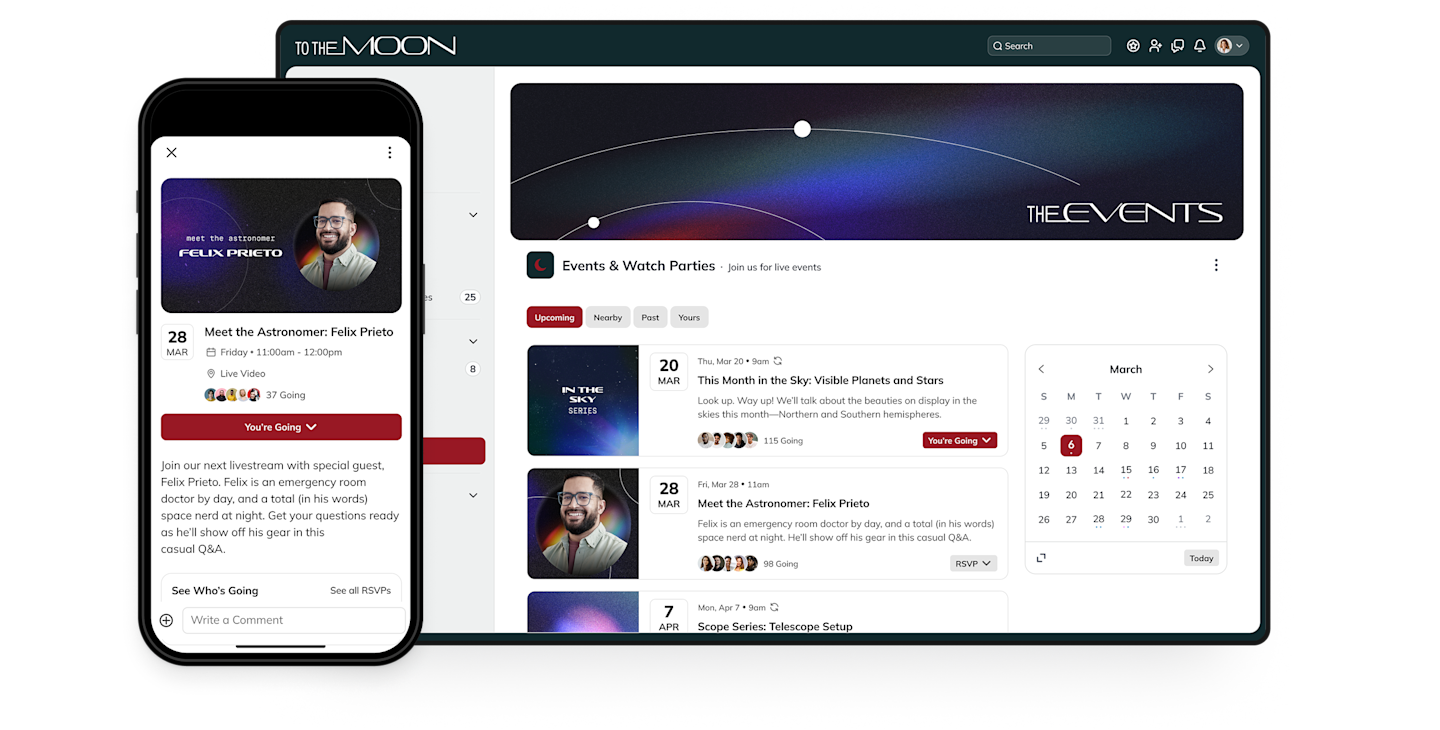Online Courses
A Guide to Synchronous vs. Asynchronous Learning in 2026
If you’re trying to figure out the best way to deliver your course material, we’ll help you decide.
Author
Last Updated
December 15, 2025

Table of Contents
Synchronous learning. Asynchronous learning.
These two terms aren’t just buzz words, and there’s a good chance that if you’re delivering any sort of online instruction, you’ve come across them.
In case you didn’t know, they basically represent the difference between following course material in real-time vs. going at your own pace. And in an age of online courses, when millions of us are taking our learning online, the perennial question is: what’s the best way to teach a course so that it serves who it needs to?
In this article, we’ll tackle this question. But fair warning, there’s no right answer. Whether synchronous or asynchronous learning is best for you and your students will depend a lot on your goals and how they like to learn. We’ll walk through each option and help you figure out which one to try.
And, spoiler alert, you don’t always have to choose either/or. There are some course platforms that give you the option to do both. We’ll talk about this too.
If you want more support in building your online course and community, come join OUR Mighty Community for free and meet other new and established community owners! We’d love to meet you. Join for free!
1. Synchronous vs. Asynchronous: What’s the difference?
If you’re trying to figure out which is right for you: synchronous vs. asynchronous, let’s talk through what each one is and what to consider when choosing.
What is synchronous learning?
Synchronous learning is when a class learns something at the same time. Traditional education is usually done through synchronous learning, where all students sit and listen to a lecture together.
Even in online classes, synchronicity (that’s fancy-speak for at the same time), can be achieved by live instruction. For example, virtual instructor-led training brings students through a learning process together from a distance. As another example, you could even argue that content that is dripped out to your ideal students is a form of synchronous learning if the students are all going through the material at the same time.
Why you might choose synchronous learning
In a time when every course can be pre-recorded, why would you still choose synchronous learning?
Well, it turns out that people like it. Often people who buy asynchronous digital courses don’t end up finishing them. When there’s no accountability and no community, it can be hard to get through a course by yourself. That’s why there’s still a market for live learning, where students can actually see the instructor face-to-face.
While it theoretically limits your scale, since you can’t just sell thousands of copies of a course recording, synchronous learning can provide a better experience for some learners. And some instructors prefer it too since it lets them feed off the energy of their students and bring their best game.
Examples of synchronous learning
Leigh Metcalf runs a community on Mighty Networks called Topstich Makers, which offers live sewing classes, in which instructors host sew-alongs and walk students through making something.
A college professor leads students through a 1-hour philosophy lecture.
A marketing expert sells tickets to a live, marketing-for-small-business webinar which she delivers virtually.
Pros and cons of synchronous learning
Pros of synchronous learning
Students benefit from a high level of engagement, building relationships with the teacher and with fellow students.
It works really well for certain learning styles. It’s especially valuable for those who aren’t as self-directed and need to be held accountable for learning.
Students can get live help or ask for clarification from the instructor.
Cons of synchronous learning
Students can get left behind, especially if they have a learning disability or socio-cultural factors threatening their success.
It’s less convenient and requires students to be able to take part live.
It can be more work for the teacher and requires teaching the same material again and again.
What is asynchronous learning?
Asynchronous learning is when the students in a class can learn at their own pace. The most common way this works is with a pre-recorded online course. Students can go through lessons as they like, and on their own time.
While online courses started as asynchronous learning, with many instructors encouraged to set up a course and forget it, more and more course businesses are also adding ways to connect as a supplement to pre-recorded courses. The most common way to do this is through an online community, which gives your students a chance to get to know each other and to gain accountability.
Why you might choose asynchronous learning
Asynchronous learning has its advantages too. The biggest advantage for your students is that they can go at their own pace. No need to try to coordinate schedules for a live session. They can get to it when they have time.
Some students with different learning styles or even learning disabilities cite asynchronous learning as giving them the freedom to learn when they want and how they want. And for people with stuff going on in life, let’s say the single parent who’s juggling upskilling with shift work, asynchronous learning makes it more likely they’ll be successful.

There are perks to asynchronous learning for you as an instructor too. While we’re not fans of the “create it and forget it” approach to e-learning (which we’ll talk about below), asynchronous learning does allow you to scale your efforts, without needing to re-teach your course live all the time.
PLUS, it might give you the option to reach more students who aren’t limited by time constraints – It’s frustrating to have a student say, “I really want to buy this course, but I can’t make it on those days.”
Examples of Asynchronous learning
A university offers a pre-recorded “Intro to Spanish” course online for distance learners, with a live exam at the end of the fall session.
An expert in graphic design records “Intro to Using Layers in Photoshop,” and puts it on Skillshare.
Pros and cons of asynchronous learning
Pros of asynchronous learning
Students can access the training anytime, from anywhere.
It works well for self-directed learners who want to go at their own pace.
Teachers can often create lesson materials once and then focus on other things (although they do need to be updated).
It integrates well with new learning techniques like microlearning.
Cons of asynchronous learning
Students have less engagement with the teacher (although a good online community can supplement this).
Students who aren’t self-directed struggle to stay engaged and may drop off.
2. Synchronous vs. Asynchronous: How to choose
So how can you choose between synchronous and asynchronous learning? There’s no one rule for every case. But this chart will give you some questions to consider when choosing between synchronous vs. asynchronous for your particular needs.
If Yes... | If No... | |
|---|---|---|
Are your students self-directed and autonomous? | Try Asynchronous | Try Synchronous |
Does your material ever change? | Try Synchronous | Try Asynchronous |
Do students require live feedback and support? | Try Synchronous | Try Asynchronous |
Do your students have limitations in joining through a live session, either because of learning style or lifestyle? | Try Asynchronous | Try Synchronous |
Will the students need to workshop ideas, have discussions, or work together? | Try Asynchronous | Try Synchronous |
3. Conclusion – Why not both?
In reality – and maybe we should have said this at the front – setting up a choice between synchronous vs. asynchronous is a bit of a false dichotomy. You can actually choose the best of both worlds and still create a great course!
One of the ways to do this is by hosting live, synchronous courses, but offering the recordings to your members. This way, when people can make it live, they can get all the benefits of those interactions. But they can catch up after too.

Another way to get the feel of a synchronous course is to add an online community to your course! This way, even if students go through the material at their own pace, you can add live Q&A sessions, co-working times, office hours, or keep the conversation going with a forum and all-member chats. The online community gives you the benefits of a synchronous course: accountability, relationship building, and getting questions answered, without the headache of running a course again and again.
There’s just one thing you need to mix asynchronous and synchronous delivery: the right platform.
You’ll need a great, all-in-one course platform that gives you the freedom to sell and deliver your course AND to add community, recordings, and more.
And that’s what we’ve built with Mighty. Our cultural software platform lets you mix courses with content, community, and commerce. It gives you the power to deliver live or prerecorded courses plus adding a bunch of other goodies your members will love: live events, live streaming, polls and questions, full-length articles, all-member chats, and more!
If you’re teaching as part of an institution or business, we also offer total white-label courses and communities, complete with your own, custom app in the app store. Come check out Mighty Pro to learn more.
Start building your course today!
Ready to start building your community?
Start a free 14-day trial to explore Mighty—no credit card required.
More like this
Join Mighty Community
Learn the principles of Community Design™ (and see them in action) alongside thousands of creators and entrepreneurs. It's free to join!

Online Courses
Creating a Course
Teaching a Course
Course Platforms
Selling a Course
Communities & Memberships
Community Platforms
Managing a Community
Building a Community
Growing a Community
Monetizing a Community
Content Creation
Creators & Entrepreneurs
Monetization
Content Creation
Starting a Business
Website Builders
Creating & Managing a Website
Events
Event Platforms
Hosting & Marketing Events
Branded Apps
Creating a Mobile App
Coaching Apps
Community Apps
Coaching
Mastermind Groups
Starting a Coaching Business
Coaching Platforms
Filter by Category
Online Courses
Communities & Memberships
Creators & Entrepreneurs
Events
Branded Apps
Coaching
Build a $1 Million Community
This free masterclass went viral—sign up to learn why.

























